Peanut Butter
How Do You Wash Down Peanut Butter Residue Easily?
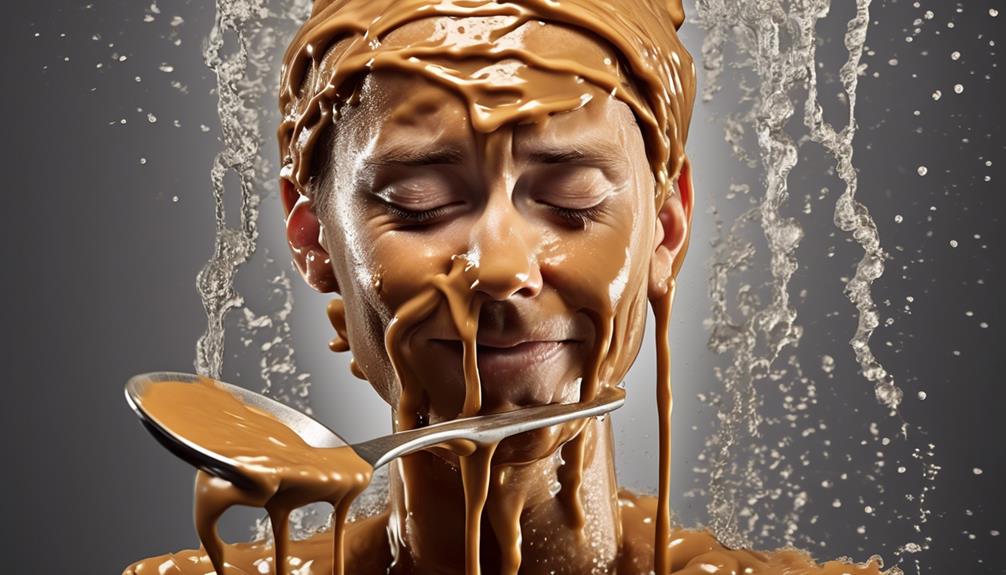
The saying goes that ‘cleanliness is next to godliness,’ and when it comes to cleaning up peanut butter, we’ve all faced the same situation – looking at a jar with leftover creamy spread, wondering how to handle the job.
It's a common conundrum, but fear not, there are numerous approaches to this sticky situation. From classic methods like using a glass of milk to more unconventional ideas like creating a smoothie sensation, the options are varied and intriguing.
So, how exactly do you wash down peanut butter? Well, let's just say there's more than one way to solve this culinary puzzle.
Key Takeaways
- Pairing peanut butter with a glass of milk is a classic and effective way to wash it down.
- Thoroughly washing surfaces with warm, soapy water and paying attention to seams and crevices helps remove peanut butter residue.
- Vinegar can be used as a natural alternative to dish detergent for cleaning peanut butter jars.
- Properly drying the jar after washing is essential to prevent mold or bacterial growth.
The Classic: Glass of Milk
We have found that pairing peanut butter with a cold glass of milk is a classic and effective way to wash down peanut butter due to the natural emulsifiers present in milk.
When the peanut butter jar needs cleaning, hot water is a simple and efficient way to clean out a peanut butter jar and minimize waste. The hot water melts the residual peanut butter, making it easier to scoop out and wash away.
It's crucial to understand the role of fat content in milk when washing down peanut butter. The fat in the milk can affect the ease of washing down the peanut butter. Different milk fat contents can be experimented with to study their effect on washing down peanut butter.
This classic combination of peanut butter and milk highlights the unique behavior of milk in washing down peanut butter, thanks to its emulsifiers. The interaction between the peanut butter and milk creates a satisfying and smooth experience, making it a go-to choice for many.
Water, Water, Everywhere

Water is a crucial ingredient in the process of washing down peanut butter. It helps to remove the sticky residue from the mouth and throat, allowing for easier swallowing.
Additionally, understanding the proper drying process after washing down peanut butter is essential to prevent any potential discomfort.
Water and Peanut Butter
When cleaning a peanut butter jar, using a rubber spatula to remove any remaining peanut butter is an effective first step.
Then, fill 1/4 of the jar with hot water and add a drop of dish soap. Screw the top back on and shake to clean the jar effectively.
Consider using vinegar as a natural alternative to dish detergent for cleaning.
Water plays a crucial role in cleaning peanut butter jars, as it helps to loosen the stubborn remnants of peanut butter, making it easier to clean. Additionally, water is essential for creating a soapy solution that aids in breaking down the oils in the peanut butter.
With these steps, water becomes an indispensable tool in maintaining cleanliness and hygiene when dealing with peanut butter residue.
Washing Technique
Utilizing a gentle scrubbing motion with a sponge and warm, soapy water facilitates the effective removal of residual peanut butter from surfaces. This technique is essential for maintaining cleanliness and preventing cross-contamination. It's important to use a gentle touch to avoid damaging the surface while ensuring thorough removal of all peanut butter remnants.
When washing down peanut butter, it's crucial to pay attention to details, such as seams and crevices where peanut butter residue can hide. Ensuring the removal of all peanut butter is vital to prevent potential allergen exposure and maintain a hygienic environment.
Additionally, rinsing surfaces with clean water after washing helps to eliminate any remaining soap and peanut butter residue, providing a safe and clean area for food preparation or consumption.
Drying Process
After ensuring thorough removal of all peanut butter remnants, the drying process is crucial to prevent mold or bacterial growth in the jar. To achieve optimal drying, consider the following techniques:
- Air Dry: Allow the jar to air dry completely before storing, ensuring that all moisture evaporates.
- Pat Dry: Use a clean cloth or paper towel to gently pat the jar dry, expediting the drying process.
- Utilize a Dish Rack: Place the jar on a dish rack to facilitate air circulation for thorough drying.
These methods will help to ensure that the jar is completely dry before sealing, preventing any potential for mold or bacterial growth.
For those seeking a quicker option, a hairdryer on a low setting can be utilized to expedite the drying process, though thoroughness is key to maintaining a mold-free environment.
Smoothie Sensation
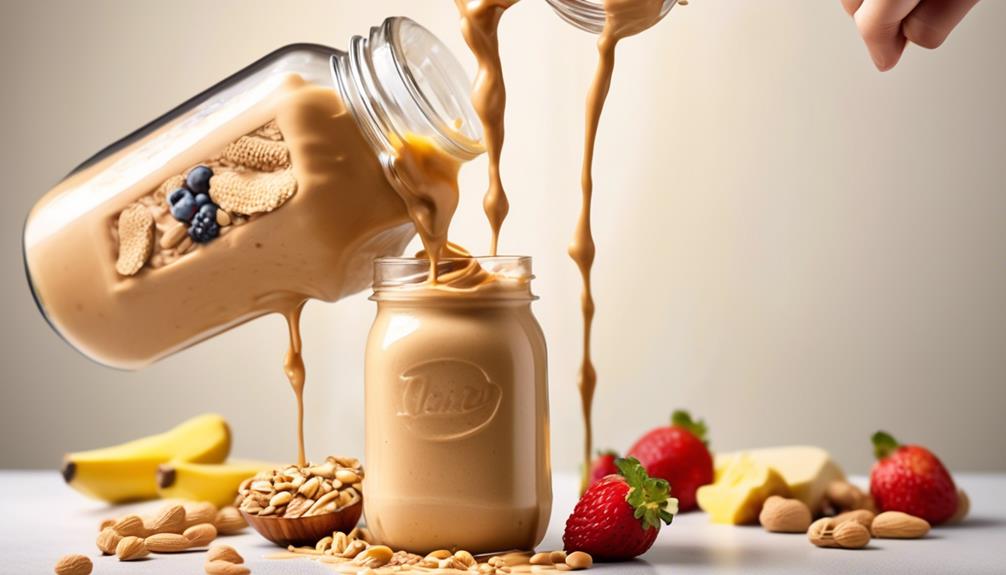
To create a delicious and nutritious smoothie, we can choose from a variety of fresh fruits and vegetables and blend them with a liquid base such as almond milk, coconut water, or yogurt to achieve the desired consistency.
By incorporating fruits like berries, bananas, and mangoes, and vegetables such as spinach or kale, we can ensure a rich infusion of essential vitamins, minerals, and antioxidants.
Adding nutritional boosts like chia seeds, flaxseeds, or protein powder can further enhance the smoothie's health benefits, providing omega-3 fatty acids, fiber, and protein.
When blending the ingredients, it's crucial to ensure a smooth and creamy texture, adjusting the thickness as needed by incorporating more liquid or frozen ingredients.
To serve, pouring the smoothie into a glass and topping it with additional fruits, nuts, or seeds can add extra texture and visual appeal.
This delightful, nutrient-packed beverage provides a convenient and enjoyable way to consume a variety of essential nutrients, making it a perfect addition to any health-conscious individual's routine.
Tea Time Solution
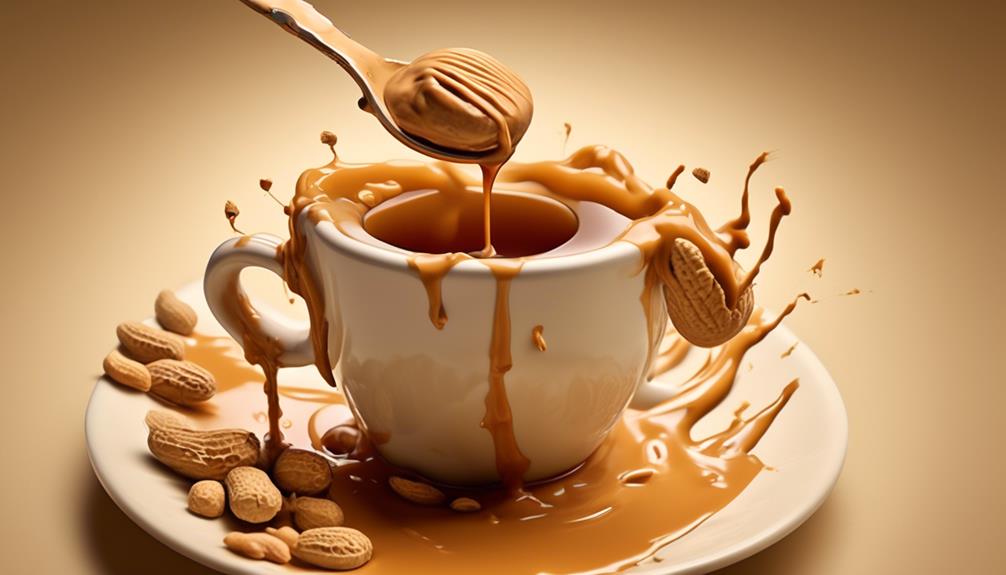
Let's talk about the health benefits of incorporating tea into your daily routine.
The antioxidants in tea can help reduce the risk of chronic diseases and boost your immune system.
Additionally, the ritual of tea time can provide a calming and relaxing break in your day.
Peanut Butter Removal
In our quest for an effective solution to remove peanut butter, we've discovered a method that incorporates the soothing ritual of tea time. After extensive experimentation, we found that the combination of tea and a few simple ingredients can effectively remove peanut butter residue from various surfaces. Here's how we do it:
- Prepare a cup of hot black tea: The tannins in black tea work as a natural cleansing agent, helping to loosen the peanut butter residue.
- Add a splash of vinegar: The acidity of vinegar aids in breaking down the fats in the peanut butter, making it easier to remove.
- Sprinkle some baking soda: This gentle abrasive helps to lift off the stubborn peanut butter remnants without causing any damage.
This method not only effectively removes peanut butter but also provides a calming and aromatic experience, making the task a delightful part of your day.
Tea Stains Solution
Our recommended solution for removing tea stains, also known as the Tea Time Solution, involves utilizing a mixture of white vinegar and water to soak tea-stained items such as cups and teapots. The acidic nature of white vinegar helps to break down the tannins in the tea, while water aids in dilution.
After soaking, gently scrub the stains with a soft brush or sponge, ensuring thorough rinsing afterwards. For stubborn stains, a paste made from baking soda and water can be applied, left to sit, and then scrubbed off before rinsing.
It's essential to completely dry the items to prevent further staining. This method is effective and environmentally friendly, providing a simple and practical solution for maintaining tea-stained items in our daily lives.
Gentle Washing Technique
Utilizing the same gentle washing technique employed in the Tea Stains Solution, we can effectively remove peanut butter residue from jars by filling them with warm water and a drop of dish soap to loosen the residue. Then, we can follow these steps:
- Gently scrub the jar with a soft sponge or cloth, avoiding harsh abrasives that could scratch the glass.
- Thoroughly rinse the jar with warm water to ensure all soap and peanut butter remnants are removed.
- Dry the jar with a soft, clean towel to prevent water spots and ensure it's ready for reuse.
This method ensures the jar is impeccably clean, ready to hold your favorite tea.
Embracing the gentle washing technique provides a sense of care and consideration for the items we use daily, enhancing our overall tea-drinking experience.
Juicy Juice
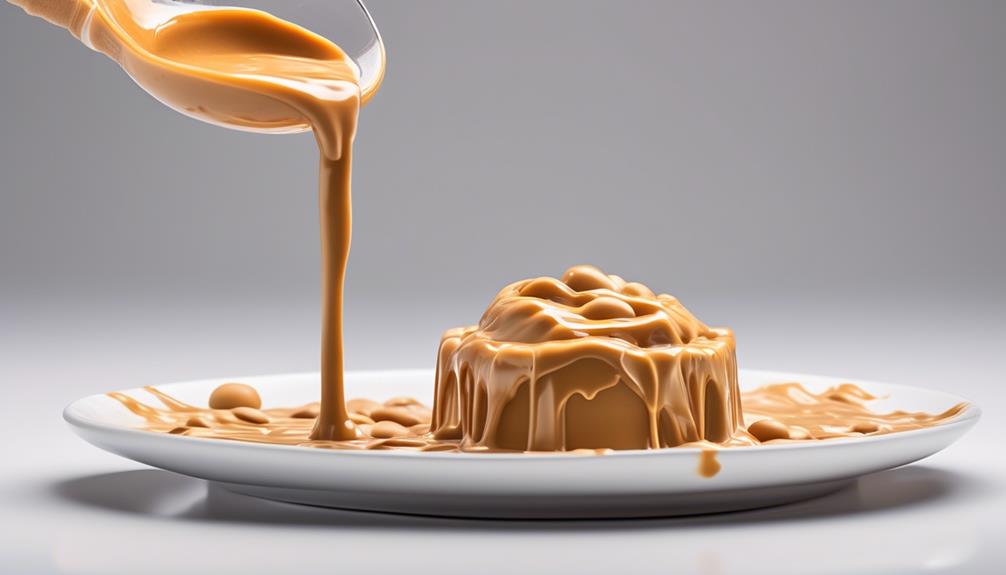
Offering a range of flavors and packaging options, Juicy Juice is a 100% fruit juice brand that provides a convenient and nutritious choice for families seeking a natural source of Vitamin C without added sugars or artificial additives.
Juicy Juice stands out as a wholesome option due to its commitment to using 100% fruit juice without added sugar or high fructose corn syrup. The brand's diverse flavor options, including apple, grape, fruit punch, and orange tangerine, cater to various taste preferences.
Additionally, the availability of Juicy Juice in bottles, juice boxes, and pouches makes it suitable for on-the-go consumption or inclusion in lunchboxes. Parents can feel confident in serving Juicy Juice to their children, as it contains no artificial preservatives, colors, or flavors. Furthermore, it serves as a good source of Vitamin C.
For families seeking an organic choice, Juicy Juice also offers organic options made from organically grown fruit. With its dedication to providing natural, nutritious fruit juice, Juicy Juice is a reliable option for those looking to incorporate healthy beverages into their daily routines.
Creamy Coffee
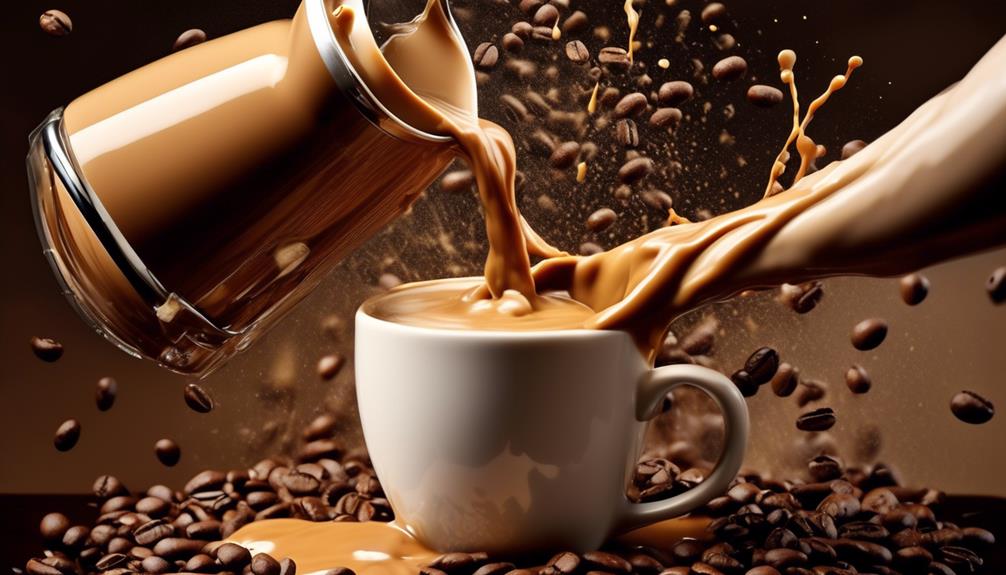
To create a creamy coffee, start by brewing a strong cup of your favorite coffee. Once you have your hot coffee ready, warm up some milk or a milk substitute in a separate container. Then, pour the warm milk into the coffee to create a luxurious, creamy texture.
Next, add a spoonful of your preferred sweetener for an extra burst of flavor. Stir the mixture well to ensure that the milk and coffee blend harmoniously, creating a delightful creamy coffee experience.
As we indulge in creamy coffee, the combination of the rich, bold coffee and the velvety smoothness of the warm milk creates a truly satisfying beverage. The addition of a sweetener enhances the flavor profile, elevating the experience to one of pure indulgence.
This creamy coffee not only provides a comforting warmth but also a delightful treat for the taste buds. It's a perfect way to start the day or to enjoy a relaxing moment of comfort and luxury.
Hydration Station

At Hydration Station, we prioritize the importance of staying well-hydrated. Our drinks are carefully formulated to provide essential hydration, energy, and nutrients.
Whether you're looking to replenish after a workout or simply need a refreshing beverage, our menu offers a variety of options to support your hydration needs.
Water and Soap
When cleaning a peanut butter jar, it's advisable to fill it with hot water and add a drop of dish soap to effectively remove residue. This method helps to break down the oils and sticky remnants left behind by the peanut butter.
After allowing the soapy water to sit for a few minutes, use a sponge or brush to scrub the jar's interior, ensuring that all surfaces are thoroughly cleaned.
Rinse the jar thoroughly with clean water to ensure all soap and peanut butter are removed, and then allow the jar to air dry completely before using it again.
If preferred, and if the jar is dishwasher-safe, consider using a dishwasher for cleaning. This ensures that the jar is hygienically clean and ready for its next use.
Rinse Thoroughly
After loosening the peanut butter residue by filling the jar with hot water and allowing it to sit, thoroughly scrub the interior using a bottle brush or sponge to ensure all remnants are removed.
It's crucial to rinse the jar with hot water, ensuring that all soap and peanut butter residue is completely removed. This step is essential in preventing any lingering flavors or residues from contaminating the next use.
Once rinsed, allow the jar to air dry completely before using it again. It's important to note that repeating the rinsing process may be necessary to ensure the jar is thoroughly clean.
Fizzy Fix
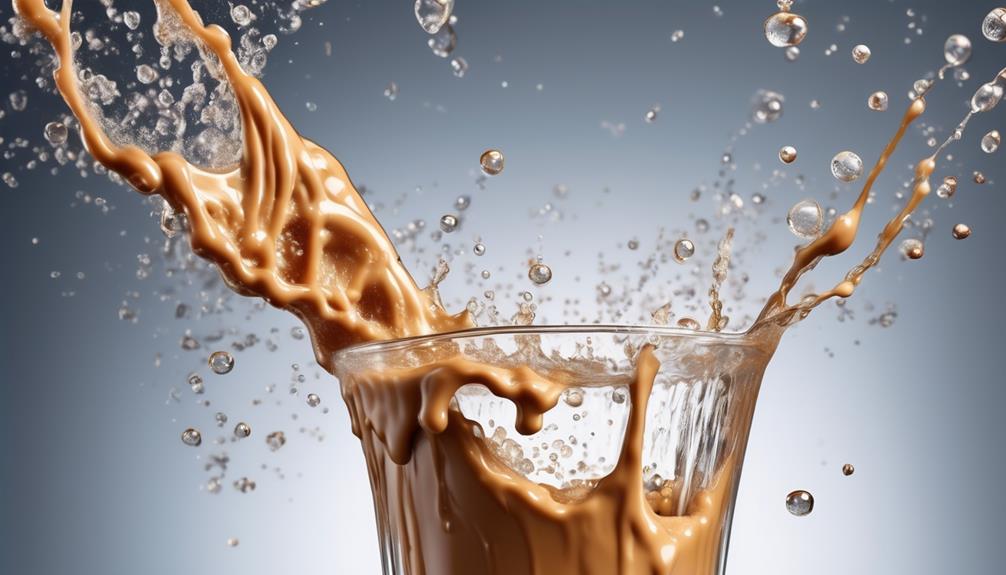
We can achieve a fizzy cleaning solution by dropping a Fizzy Fix tablet into a jar filled with water and allowing it to dissolve. This creates a powerful cleaning agent that effectively removes peanut butter residue and leaves the jar fresh and ready for reuse.
- Drop the Fizzy Fix tablet into the water-filled jar and watch it fizz as it dissolves, releasing its cleaning power.
- Use a brush or sponge to scrub the jar with the fizzy solution, ensuring that all areas are thoroughly cleaned and any stubborn peanut butter remnants are lifted away.
- Rinse the jar thoroughly with water to remove any residue, leaving it sparkling clean and free from any cleaning solution.
Using Fizzy Fix not only makes cleaning your peanut butter jars an easy task, but it also ensures that they're sanitized and free from any lingering traces of peanut butter. This method provides a simple and effective way to keep your jars in pristine condition, ready for the next use.
Coconut Water Craze
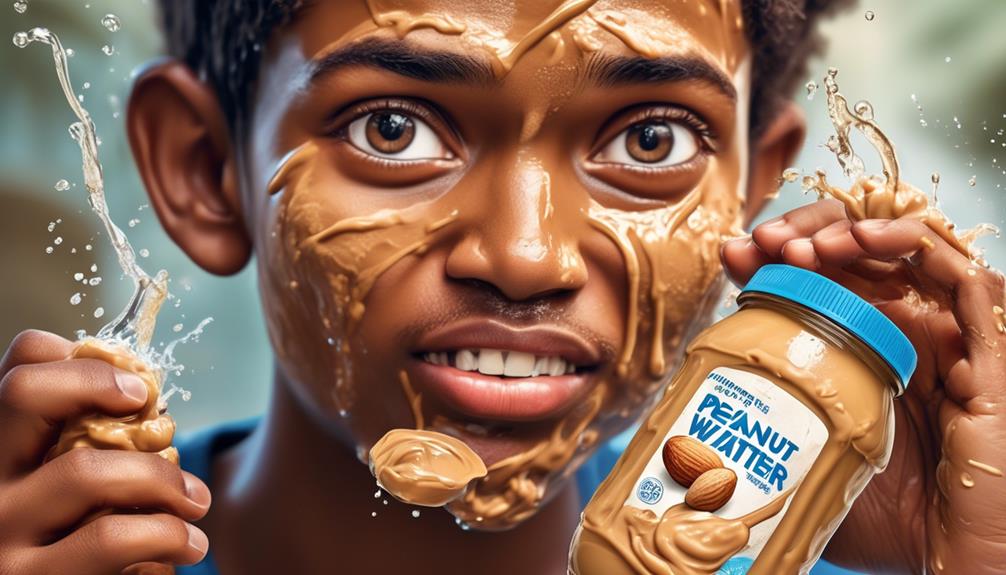
The current trend of coconut water consumption reflects a growing preference for natural and hydrating beverages with high potassium content. Coconut water has gained popularity as a post-workout hydration choice due to its electrolyte-replenishing properties. It is also favored for its refreshing taste and natural hydration benefits. This tropical beverage has become a staple in many people's diets, often used as a base for smoothies and cocktails. Additionally, the availability of flavored coconut water options caters to diverse taste preferences, further adding to its appeal.
| Benefits | Flavored Options |
|---|---|
| High potassium content | Mango |
| Natural electrolytes | Pineapple |
| Hydrating properties | Passion Fruit |
Coconut water is not just a fad; it is a nutritious and delicious beverage that offers a natural way to stay hydrated. With its potassium-rich composition and natural electrolytes, it stands out as a satisfying alternative to sugary drinks. The coconut water craze is not just a passing trend but a reflection of our collective desire for healthier, more natural beverage options.
Herbal Infusion
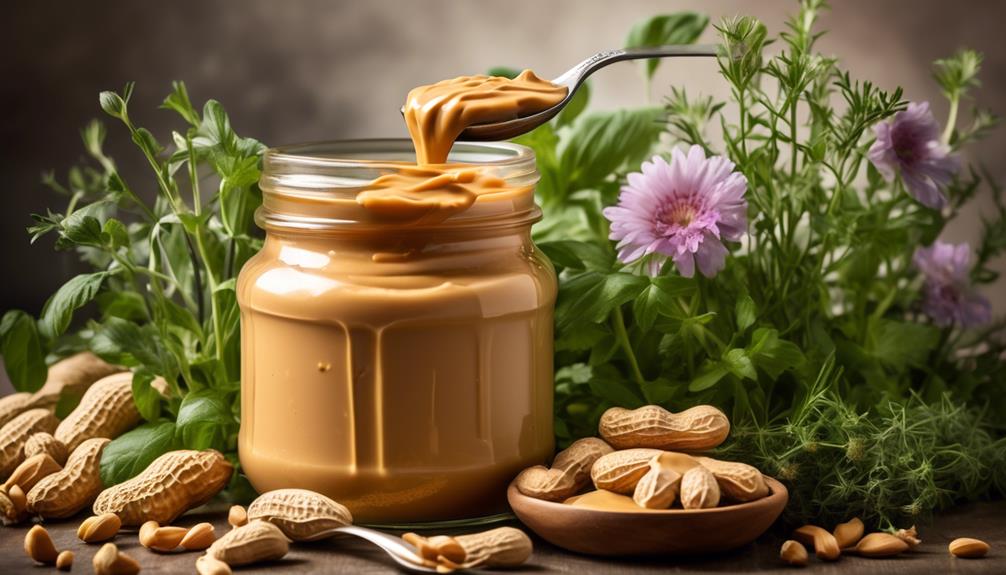
Indulge in the aromatic and beneficial experience of herbal infusion by selecting your preferred herbs and steeping them in hot water for 5-10 minutes. Choose from a variety of herbs such as chamomile, peppermint, or lavender, each offering unique flavors and potential health benefits.
Prepare the herbs by rinsing them under cold water to remove any dirt or debris, ensuring a clean and pure infusion. Heat the water to boiling point and pour it over the herbs in a heatproof container, allowing the hot water to extract the essential oils and compounds from the herbs.
Let the herbs steep in the hot water for the recommended time to infuse the water with their flavors and potential health-promoting properties. Finally, strain the herbs from the water and savor the resulting herbal infusion, whether enjoyed hot or cold.
This simple yet delightful process allows for a moment of tranquility and wellness, as you embrace the soothing essence of your chosen herbal blend.
Frequently Asked Questions
How Do You Remove Peanut Butter From Clothes?
We remove peanut butter from clothes by following these steps:
- Scrape off excess peanut butter.
- Apply a stain remover or liquid laundry detergent directly to the stained area.
- Gently rub the fabric together to work the detergent in.
- Wash the clothing in the hottest water temperature safe for the fabric.
- After washing, check to ensure the stain is completely removed before drying.
What Breaks Down Peanut Butter?
Soap and water effectively break down peanut butter by emulsifying the fats and lifting the residue.
Vinegar also serves as a cleaning agent, aiding in dissolving the peanut butter.
Scrubbing with eggshells, involving your dog, or enjoying it with ice cream can also help remove the residue.
These methods provide practical and safe ways to clean peanut butter containers, maintaining hygiene and preventing waste.
How Do You Get Peanut Butter Out of the Bottom of a Jar?
How do we get peanut butter out of the bottom of a jar?
Scraping with a rubber spatula is effective.
Then we can fill 1/4 of the jar with hot water and a drop of dish soap, shaking it.
Alternatively, we can use vinegar and hot water, or eggshells with hot water to scrub off the peanut butter.
Another option is giving the jar to a dog to lick clean, ensuring safety precautions are taken.
Why Is Peanut Butter Hard to Clean?
Peanut butter is hard to clean because of its thick, sticky consistency. The oils and proteins in peanut butter can form a stubborn residue.
To wash it down effectively, we recommend using warm, soapy water and a scrubbing brush to break down the oils and proteins. It's important to use hot water to help dissolve the peanut butter, making it easier to clean.
Additionally, soaking the utensils or jar in hot, soapy water can help loosen the residue.
Conclusion
In conclusion, there are numerous ways to wash down peanut butter, each with its own benefits.
Whether it's a classic glass of milk, a refreshing glass of water, or a nutritious smoothie, there's a method for everyone.
Remember, variety is the spice of life, so don't be afraid to try different options to find what works best for you.
After all, there's more than one way to skin a cat!
Stay hydrated and enjoy your peanut butter in whatever way suits you best.
From sneaky childhood butter licks to penning some of our most popular articles, Jamie’s journey with butter has been lifelong. His culinary background gives him a unique perspective, allowing him to craft mouthwatering articles that educate and tantalize equally. Jamie’s travel adventures revolve around finding the world’s best buttery treats when he isn’t writing.
Peanut Butter
What Makes Peanut Butter Whiskey Unique?

So, you're curious about peanut butter whiskey? Well, it's certainly an intriguing concept, isn't it?
The idea of blending the rich, nutty flavor of peanut butter with the warmth of whiskey is something that piques the interest of many.
But how does it actually taste? Is it a gimmicky novelty or a genuinely enjoyable spirit?
Let's explore the world of peanut butter whiskey and uncover what makes it a standout in the realm of flavored spirits.
Key Takeaways
- Peanut butter whiskey offers a unique flavor profile, combining the rich, nutty taste of peanut butter with the smooth warmth of whiskey.
- It appeals to both whiskey enthusiasts and those with a sweet tooth, offering a velvety, nutty sweetness on the palate.
- With an initial aroma reminiscent of freshly ground peanuts, it provides a familiar and comforting warmth of whiskey on the finish.
- Peanut butter whiskey has gained popularity due to its exceptional taste, appealing to those who prefer sweeter alcohol options and expanding the flavored whiskey market in the United States.
Peanut Butter Whiskey: A Unique Flavor Profile
Peanut butter whiskey offers a unique flavor profile that combines the rich, nutty taste of peanut butter with the smooth warmth of whiskey, creating a distinctive and indulgent drinking experience.
The marriage of whiskey and peanut butter creates a surprisingly delightful fusion that appeals to both whiskey enthusiasts and those with a sweet tooth. This flavored whiskey introduces a whole new dimension to the world of spirits, challenging traditional notions of what whiskey can be.
The initial aroma is reminiscent of freshly ground peanuts, followed by a velvety, nutty sweetness on the palate, which then gives way to the familiar, comforting warmth of whiskey as it goes down. The interplay of these flavors creates a truly unique drinking experience that's both familiar and novel at the same time.
The balance between the distinct nuttiness and the classic whiskey notes is what sets peanut butter whiskey apart, making it an intriguing choice for those seeking a departure from conventional whiskey flavors.
Understanding the Alcohol Content
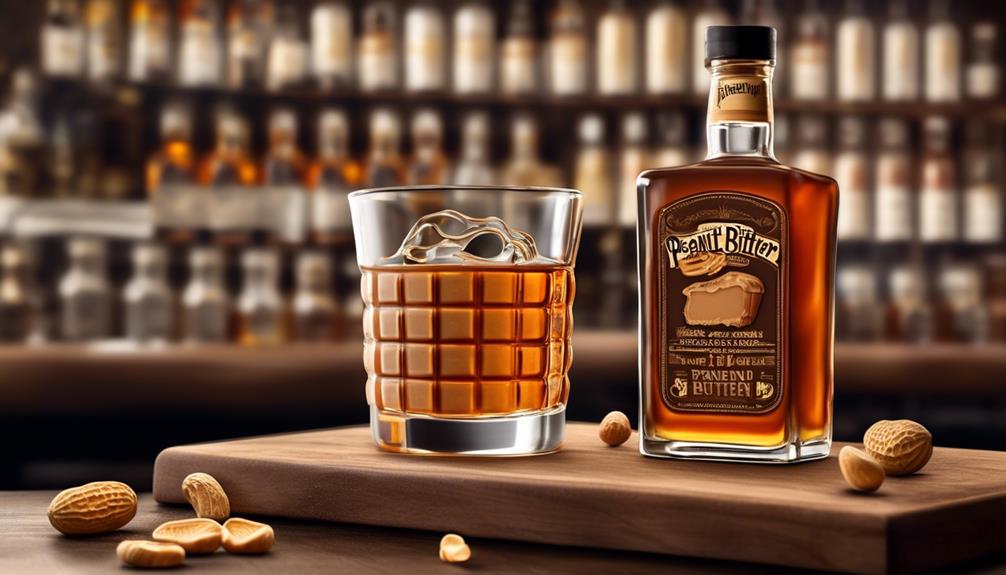
As we continue our exploration of peanut butter whiskey's unique qualities, it's important to understand the alcohol content of this distinct spirit and how it sets it apart from traditional whiskeys.
Unlike typical American whiskey, peanut butter whiskey is known for its lower alcohol percentage, ranging from 30 to 35%, approximately 70 proof, which is notably lower than traditional whiskey's 80 proof. While this places it outside the classification of Scotch whisky according to EU standards, peanut butter whiskey doesn't make such claims.
Despite its lower alcohol by volume (ABV), the whiskey flavored with peanut butter has gained popularity due to its exceptional taste, appealing particularly to those who prefer sweeter alcohol or who previously believed they didn't enjoy whiskey.
For those interested in understanding the alcohol content of different brands, Bartendr provides a comprehensive guide, offering a roundup of the most common peanut butter whiskey brands and their alcohol percentages. This knowledge is crucial for consumers to make informed decisions before purchasing or selecting serving sizes.
Understanding the distinctive alcohol content of peanut butter whiskey is essential to fully appreciate its unique qualities and make the most of this flavorful spirit.
Serving Suggestions and Pairings
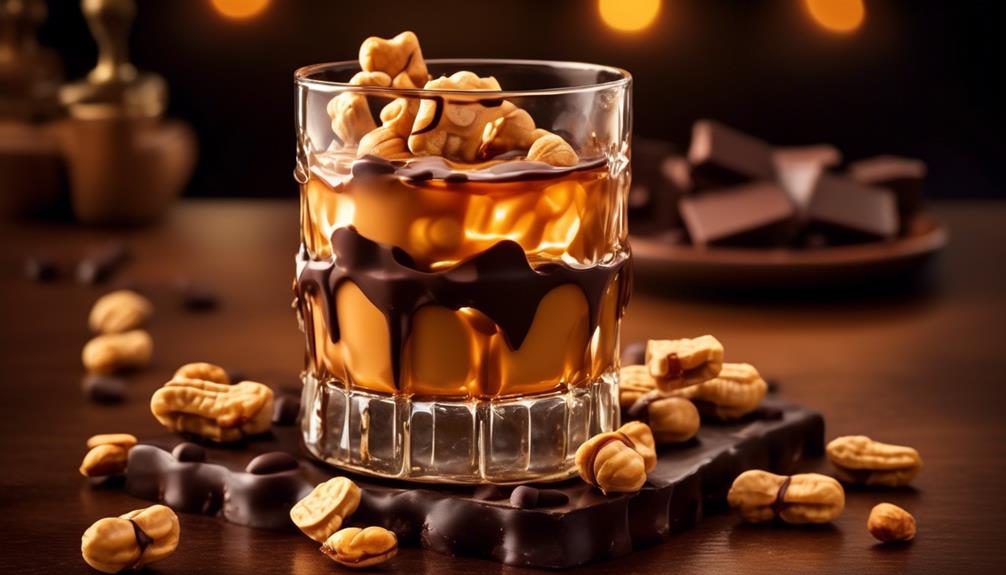
When considering serving suggestions and pairings for Skrewball Peanut Butter Whiskey, various options allow for a versatile and enjoyable drinking experience. Skrewball can be savored neat, on the rocks, or with a splash of water, enhancing its delightful aromatics and flavors.
Additionally, the whiskey can be paired with jammy cassis for a delightful enhancement of fruity flavors, or added to an old-fashioned cocktail for a nutty twist. For those seeking to experiment, mixing Skrewball with alcohols like RumChata, vanilla vodka, and caramel liqueur offers rich and complementary flavors.
Alternatively, trying it with coffee, Coca-Cola, apple cider, berry-flavored seltzer, or chocolate milk provides unique one-ingredient mixers. The versatility of Skrewball opens up new possibilities for whiskey enthusiasts to explore and enjoy creative cocktail combinations.
For further inspiration, the Skrewball website offers additional serving suggestions and cocktail recipes to elevate your next drink with this distinctive flavored whiskey. With these options, Skrewball Peanut Butter Whiskey promises an exciting and flavorful drinking experience.
Exploring Popular Peanut Butter Whiskey Brands

With the rise in popularity of flavored whiskies, a new category has emerged, introducing unique and unconventional flavors to the market. Among these, peanut butter whiskey has garnered significant attention. One of the most popular brands in this category is Skrewball Peanut Butter Whiskey, which has made a mark with its genuine peanut butter aroma and taste. This American whiskey flavored with peanut butter has gained a devoted following due to its unconventional yet enjoyable drinking experience. Created by Steven Yeng and his wife Brittany in San Diego, this flavored whiskey has experienced remarkable growth, evidenced by a staggering 1,976% increase in 2021 and its subsequent acquisition by drinks giant Pernod Ricard in 2023.
The rise of Skrewball Peanut Butter Whiskey also reflects the expanding flavored whiskey market in the United States, with major brands like Fireball, Jim Beam, and Jack Daniels venturing into this space. Skrewball, made with a base of corn and barley, infused with natural flavors, has become renowned for its refusal to provide extensive technical information, emphasizing its unique flavor profile. This versatile whiskey can be enjoyed on its own, mixed in cocktails, or paired with various flavors, offering a creative and adaptable drinking experience.
Making the Most of Skrewball Whiskey
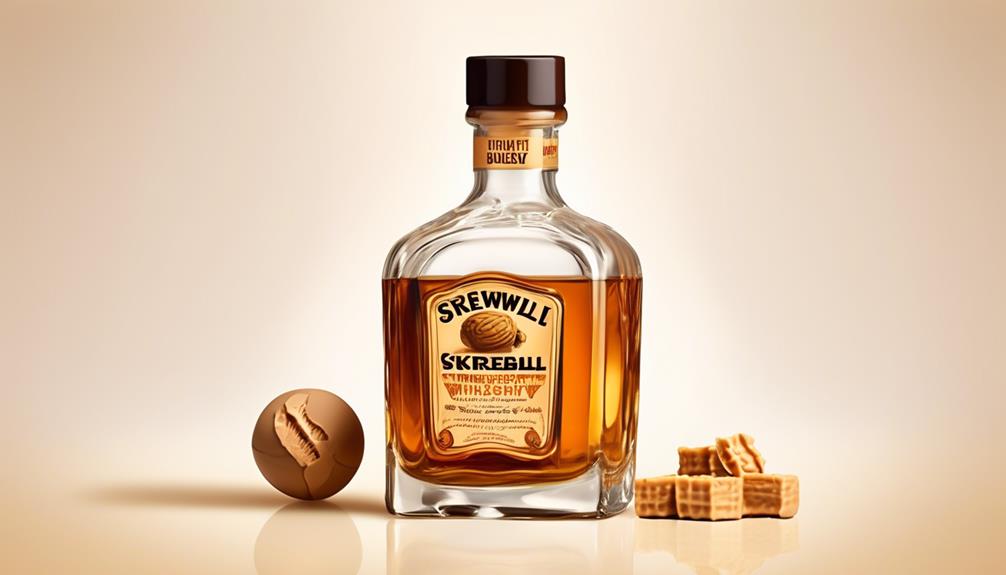
Exploring the versatility and unique flavor profile of Skrewball Peanut Butter Whiskey allows for a delightful and adaptable drinking experience, making it a standout choice in the flavored whiskey market. Skrewball isn't only a delightful sipping whiskey but also a versatile ingredient for crafting innovative cocktails.
Here's how to make the most of Skrewball Whiskey:
- Mixology Mastery: Experiment with Skrewball in classic cocktails like Old Fashioneds or create your own unique concoctions to elevate your mixology skills.
- Decadent Desserts: Infuse your desserts with the rich, nutty flavor of Skrewball, adding a delightful twist to your culinary creations.
- Liquor Store Finds: Seek out Skrewball at your local liquor store and explore the endless possibilities it offers for your home bar.
- Unconventional Pairings: Pair Skrewball with unexpected flavors like chocolate, banana, or even chili for an adventurous tasting experience.
- Whiskey-Flavored Adventures: Take your taste buds on a journey by incorporating Skrewball into your next whiskey tasting session, and savor its unique aroma and taste.
Skrewball Peanut Butter Whiskey opens up a world of flavor possibilities, perfect for those seeking a departure from traditional whiskey experiences.
Mixing and Cocktail Recipes
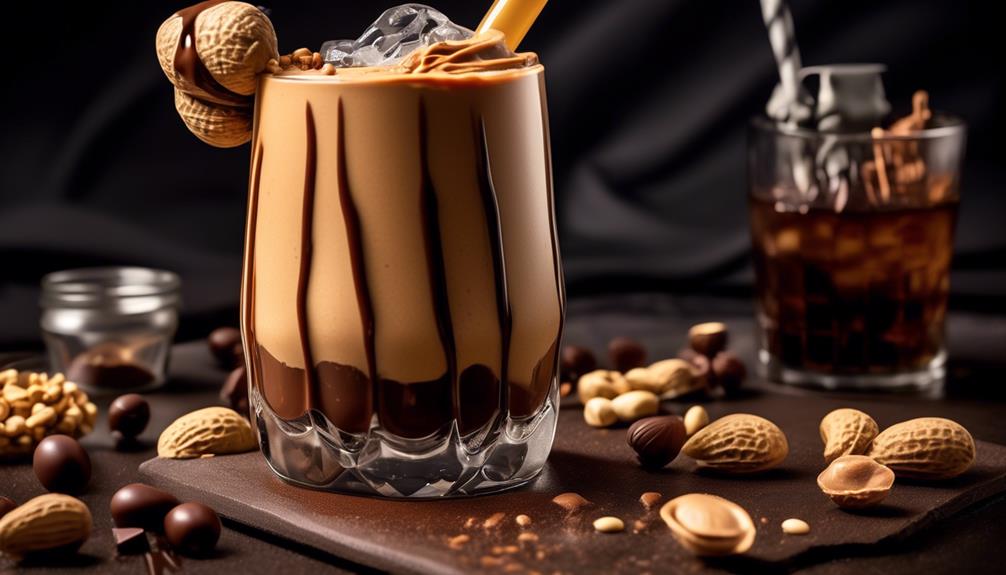
Let's dive into the art of mixing and crafting delectable cocktail recipes using Skrewball Peanut Butter Whiskey, adding a unique twist to traditional libations. Skrewball Peanut Butter Whiskey offers a delightful combination of whiskey flavored with the nutty richness of peanut butter, allowing for the creation of innovative cocktail recipes that tantalize the taste buds. Experimenting with mixing Skrewball with ingredients like jammy cassis, old-fashioned mixers, or complementary spirits such as RumChata and vanilla vodka can result in rich and distinct flavors. The versatility of Skrewball enables the crafting of unique cocktails, including the Graper Manhattan or the Peanut Butter and Honey Old-Fashioned (Winnie's Cup). When mixing Skrewball, it's crucial to consider its sweetness and balance it with other flavors to create well-rounded and enjoyable cocktails. For further inspiration, Skrewball's website offers a variety of well-balanced cocktail recipes, providing guidance for those looking to explore the distinct flavor profile of peanut butter whiskey in mixed drinks.
| Mixing Ideas | Cocktail Recipes |
|---|---|
| Jammy Cassis | Graper Manhattan |
| Old-Fashioned Mixers | Peanut Butter and Honey Old-Fashioned |
| Complementary Spirits (RumChata) | – |
Where to Find Peanut Butter Whiskey

We can easily find popular brands of peanut butter whiskey at our local liquor stores, such as Skrewball, Sheep Dog, and Ole Smoky.
If we prefer the convenience of online shopping, various retailers and alcohol delivery services offer peanut butter whiskey for purchase and delivery.
Additionally, Total Wine is a great option for those seeking a diverse selection of peanut butter whiskey, while specific venues like OB Noodle House Bar 1502 in San Diego may offer the original Skrewball peanut butter whiskey.
Popular Brands Available
Peanut butter whiskey has gained popularity in recent years, with several notable brands like Skrewball, Sheep Dog, and Ole Smoky entering the flavored whiskey market and becoming readily available at liquor stores across the U.S.
- Skrewball Peanut Butter Whiskey offers a genuine peanut butter aroma and taste, providing a unique drinking experience.
- The market has seen significant growth, with major brands like Skrewball, Sheep Dog, and Ole Smoky entering the flavored whiskey market.
- You can find peanut butter whiskey at practically any liquor store in the U.S. and online through retailers like Total Wine.
- Peanut butter whiskey typically has a lower alcohol percentage, around 30-35% ABV, making it sweeter and suitable for mixed drinks.
- Skrewball Peanut Butter Whiskey can be enjoyed alone, in cocktails, or paired with complementary flavors, offering new possibilities for whiskey enthusiasts.
Online and Local Stores
With the growing availability of peanut butter whiskey at both online and local liquor stores, enthusiasts can easily explore a wide range of popular brands such as Skrewball, Sheep Dog, and Sqrrl, as well as other lesser-known options. Check out the table below to discover where you can find these delectable bottles:
| Store | Online Availability | Physical Locations |
|---|---|---|
| Total Wine | Yes | Yes |
| OB Noodle House | No | Yes (San Diego) |
| Bartendr | Yes | No |
| Local Liquor Stores | Varies | Yes |
Peanut butter whiskey, a creation often likened to the nostalgic flavors of peanut butter and jelly, is now easily accessible for both online and in-store purchases. Whether you're seeking the original Skrewball peanut butter whiskey that's a San Diego specialty or looking to explore new flavors like raspberry liqueur-infused options, the options are plentiful. Steven Yeng's innovative fusion of whiskey and peanut butter has truly revolutionized the spirit market.
Specialty Liquor Shops
Exploring specialty liquor shops allows enthusiasts to discover a diverse selection of peanut butter whiskey brands and unique variations, offering a rich opportunity for expanding one's palate and exploring the world of flavored spirits. When seeking out peanut butter-flavored whiskey, specialty liquor shops are an ideal destination due to their distinct advantages:
- They often carry a range of peanut butter whiskey brands, including popular options like Skrewball, Sheep Dog, Ole Smoky, and Skatterbrain.
- Many offer online purchasing and delivery options for convenient access.
- Some stock exclusive or limited edition peanut butter whiskey variations.
- Knowledgeable staff can offer guidance on selection, serving suggestions, and cocktail recipes.
- Visiting provides an opportunity to explore other unique flavored spirits, expanding one's palate beyond peanut butter whiskey.
Frequently Asked Questions
Does Peanut Butter Whiskey Taste Good?
Tastes vary, but we find peanut butter whiskey to be surprisingly delicious. It offers a unique blend of genuine peanut butter flavor and a hint of whiskey bite, making it an enjoyable and versatile spirit.
Its boozy lift complements creative cocktail combinations, and the subtle buttery pastry notes add complexity. While it may not suit everyone's taste, it's a milder option at around 30 to 35% alcohol, making it appealing to those who prefer sweeter alcohol or thought they didn't like whiskey.
Can You Drink Peanut Butter Whiskey Straight?
Absolutely, you can drink peanut butter whiskey straight. The rich, nutty flavor of the whiskey shines through when sipped neat, creating a smooth and indulgent experience. It's a great way to fully appreciate the unique taste profile of the spirit.
The creamy texture and hints of roasted nuts make it a delightful choice for savoring on its own.
How Is Skrewball Peanut Butter Whiskey Made?
Skrewball Peanut Butter Whiskey is made with a blend of corn and barley, infused with natural flavors, giving it an authentic peanut butter taste and aroma. Details of its production, like age statement, aren't disclosed.
It's a versatile spirit, enjoyable on its own or in cocktails, offering a fun and unique flavor profile. It pairs well with flavors like cassis and chocolate, providing a nutty twist to classic cocktails.
Is Skrewball Actually Good?
Oh, Skrewball Peanut Butter Whiskey? It's a game-changer.
The genuine peanut butter flavor and aroma set it apart, making it a delightful surprise for the palate.
The smooth, versatile nature of Skrewball makes it great for sipping on its own or getting creative with cocktails.
Its popularity and market relevance speak volumes about its quality.
Trust us, it's a winner.
Conclusion
In a world full of traditional whiskeys, peanut butter whiskey stands out as a unique and flavorful option. Its rich and smooth taste, reminiscent of a childhood favorite, offers a nostalgic and comforting experience.
Just like spreading peanut butter on warm toast, peanut butter whiskey brings warmth and comfort to any occasion. It's a symbol of creativity and innovation in the world of spirits, and a must-try for anyone looking to add a twist to their whiskey collection.
From sneaky childhood butter licks to penning some of our most popular articles, Jamie’s journey with butter has been lifelong. His culinary background gives him a unique perspective, allowing him to craft mouthwatering articles that educate and tantalize equally. Jamie’s travel adventures revolve around finding the world’s best buttery treats when he isn’t writing.
Peanut Butter
Exploring Peanut Butter Price Trends: Factors Impacting Cost
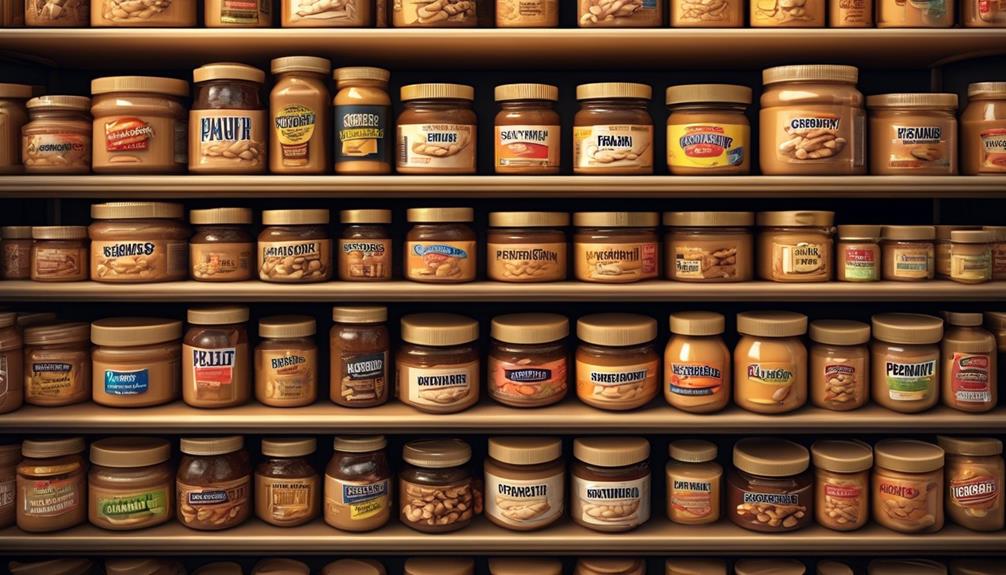
We've all experienced the sticker shock at the grocery store when we reach for our favorite jar of peanut butter, only to find that the price has increased yet again. It leaves us wondering, why is peanut butter so expensive?
Well, there are several factors at play that contribute to the price of this beloved spread. From the cost of peanuts themselves to the impact of market demand and branding, the reasons behind the price of peanut butter might surprise you.
Let's explore the various factors that make peanut butter price what it is and uncover the complexities behind this pantry staple.
Key Takeaways
- Adverse weather conditions and reduced peanut production are contributing factors to the increase in peanut butter pricing.
- High demand for peanut butter among health and fitness enthusiasts is driving up its price.
- Marketing efforts and branding strategies play a role in the higher pricing of peanut butter.
- Packaging and perceived value also impact the pricing of peanut butter.
Factors Affecting Peanut Butter Pricing
Experiencing a shortage due to sweltering temperatures and smaller crops, peanut butter pricing is being affected by various factors in the market.
The Peanut Belt states of Georgia and Texas, which usually yield substantial peanut crops, have been hit by adverse weather conditions, leading to a decrease in peanut production. This scarcity has a direct impact on peanut butter prices, as the reduced supply drives up costs for manufacturers. Companies such as J.M. Smucker Co. are already planning to raise prices in response to the smaller crop, further contributing to the increase in peanut butter pricing.
Additionally, the high demand for peanut butter, fueled by its popularity among health and fitness enthusiasts, as well as shifting consumer preferences, has played a significant role in driving up its cost. Furthermore, the marketing efforts and branding strategies employed by peanut butter companies to stand out in the competitive peanut butter market have also contributed to the higher pricing of peanut butter.
The cost of storing and handling peanuts, including additional expenses for proper storage and transportation, further influences the pricing of peanut butter.
These multiple factors combined have led to the current state of peanut butter prices, making it essential for consumers to find peanut butter that fits within their budget.
Influence of Market Demand
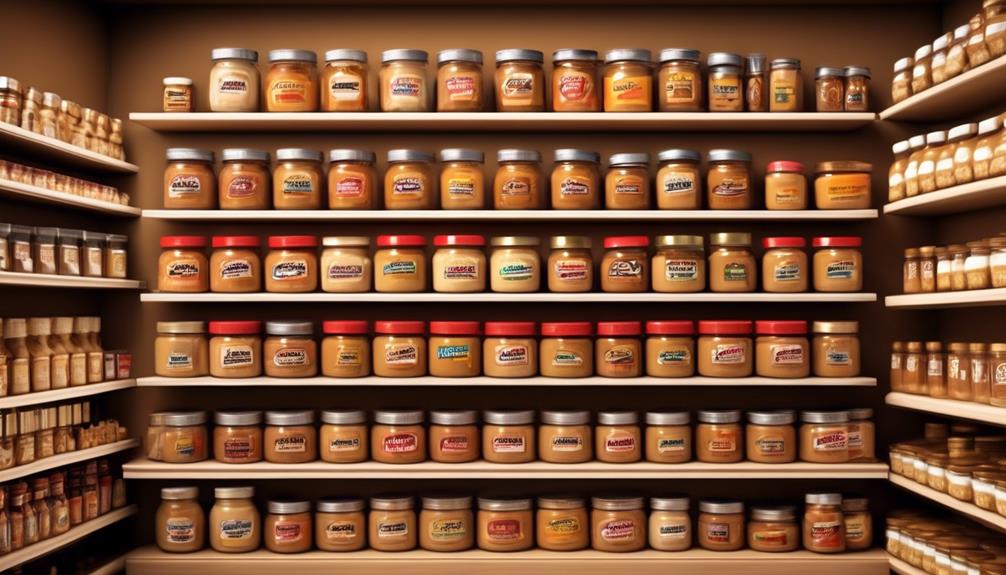
The high demand for peanut butter, driven by its popularity among health and fitness enthusiasts, significantly influences its market pricing. As the demand for peanut butter rises, so does its price. This increase in demand has a direct impact on the cost of peanut butter, driving it up as suppliers and producers seek to capitalize on the market trend.
This is evident in the current pricing, where peanut butter prices have risen by several cents per unit due to the surge in demand. The market demand for peanut butter not only affects its retail cost but also influences various factors contributing to its pricing, such as production, marketing, and distribution.
Additionally, the competitive nature of the market further propels the pricing of peanut butter, as brands invest heavily in marketing to differentiate themselves, passing on these costs to consumers. Moreover, limited availability in certain regions due to imports results in higher transportation and importation costs, further elevating the price of peanut butter.
Therefore, the influence of market demand plays a pivotal role in determining the price of peanut butter, affecting consumers' purchasing power and consumption patterns.
Impact of Branding on Price

When considering the impact of branding on the price of peanut butter, it's crucial to analyze the relationship between brand reputation and pricing.
Packaging plays a significant role in shaping consumers' perceived value of the product, which directly influences pricing strategies.
Additionally, the influence of advertising on consumer perception and pricing strategy can't be overlooked.
Brand Reputation and Price
Brand reputation significantly influences the pricing of peanut butter. Market-dominating brands like J.M. Smucker Co. are able to command higher prices due to their strong brand recognition and reputation. This is because their brand reputation gives consumers the perception of quality and reliability, allowing them to justify paying a premium price. The cost of marketing efforts, including sophisticated branding and organic credentials, is passed on to consumers, further impacting the price of peanut butter.
However, for consumers looking to avoid paying premium prices associated with fancy branding, store brands or budget options offer a more affordable alternative. These brands often have lower marketing costs, allowing them to offer peanut butter at a lower price point.
In addition to brand reputation, there are other factors that contribute to the overall price of peanut butter. The cost of ensuring peanuts are stored correctly, transportation and importation costs, and the manufacturing process all play a role in determining the final price. These costs are influenced by brand reputation and the associated production and handling costs.
Even within leading brands like Jif and Skippy, there are different pricing strategies. Wholesale clubs, for example, often offer competitive prices for both generic and name brand peanut butter. This illustrates the impact of brand reputation on pricing within the market.
Packaging and Perceived Value
Analyzing the impact of packaging on perceived value reveals the intricate relationship between branding and pricing in the peanut butter market.
- Packaging creates a visual and psychological connection, influencing consumers' perception of quality and value.
- Branding and packaging convey a story and lifestyle, enticing consumers to associate higher value with certain brands.
- Innovative and sustainable packaging designs can elevate the perceived value, justifying premium pricing for peanut butter products.
The packaging of peanut butter plays a pivotal role in shaping consumers' perception of its value. It serves as a tangible representation of the brand and its quality, influencing purchasing decisions. As consumers, we're drawn to packaging that communicates quality and aligns with our values, ultimately impacting the price we're willing to pay for peanut butter.
Advertising and Pricing Strategy
The impact of packaging on perceived value in the peanut butter market underscores the significance of advertising and branding efforts in shaping pricing strategies for different brands.
As companies invest in marketing to differentiate themselves and appeal to health-conscious consumers, these efforts significantly influence the pricing of peanut butter. The costs associated with marketing and branding are ultimately passed on to the buyers, contributing to the overall price of peanut butter. This phenomenon makes store brands or budget options an attractive cost-saving alternative for price-conscious consumers.
Additionally, the effective communication of product benefits and unique selling propositions through advertising can justify premium pricing for certain brands. Therefore, advertising and branding play a pivotal role in determining the perceived value of peanut butter, enabling companies to implement diverse pricing strategies to cater to varying consumer segments and preferences.
Cost of Peanuts Storage

Proper storage and transportation of peanuts significantly impact their quality and directly influence the pricing of peanut butter. The cost of ensuring peanuts are stored correctly is reflected in the pricing of peanut butter. Careful handling and storage are necessary to maintain the quality of peanuts. The high fat content of peanuts makes them difficult to store, requiring specific conditions to prevent spoilage.
The proper storage and transportation of peanuts incur additional costs for manufacturers. Incorrectly stored peanuts develop a chemical-like smell and taste bitter or sour, making them unsuitable for peanut butter production. These factors emphasize the importance of investing in adequate storage facilities and transportation methods to maintain the integrity of the peanuts used in peanut butter production.
The cost of peanuts storage is a crucial aspect that directly impacts the overall price of peanut butter. Manufacturers must bear the expenses associated with maintaining optimal storage conditions to ensure the peanuts' quality, which inevitably influences the final pricing of peanut butter for consumers.
Import Challenges for Peanut Butter

Importing peanut butter from countries with limited peanut cultivation presents significant challenges, impacting transportation costs and availability. Limited peanut cultivation in certain countries leads to a heavy reliance on imports, resulting in increased transportation and importation costs. Additionally, importing peanut butter from countries with different growing conditions can lead to higher prices due to limited availability and increased demand. This directly affects the price and accessibility of peanut butter in the United States, making it challenging for some regions to obtain at a reasonable cost.
Expats living abroad often face difficulties in obtaining peanut butter due to limited availability and higher costs of imported peanut butter. As a result, they often rely on friends and family to bring peanut butter when visiting. The availability and demand for peanut butter in different countries further complicate the import challenges, ultimately leading to increased prices for consumers. The additional expenses incurred in the transportation and importation processes contribute to the overall price of peanut butter in the market.
Manufacturing Process Costs
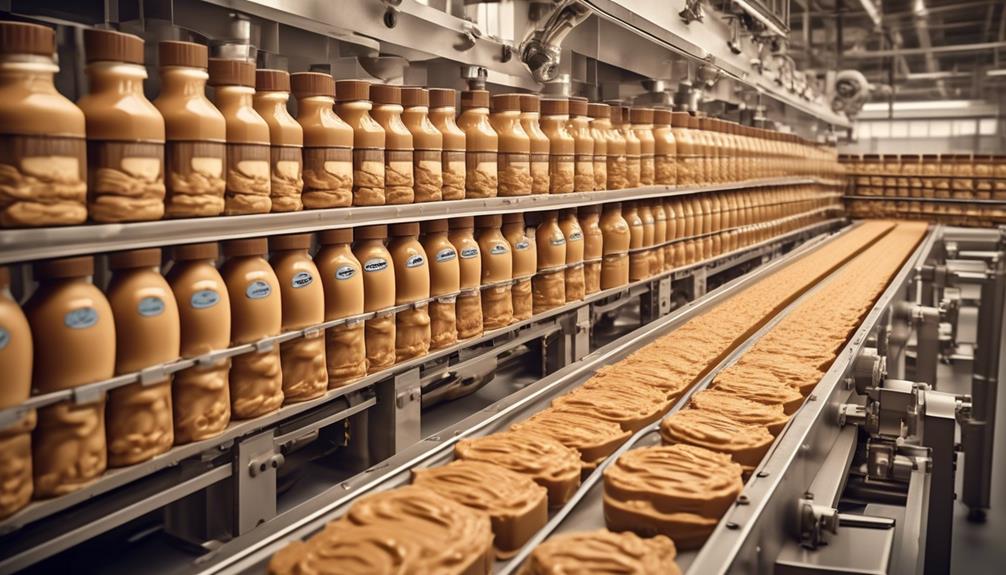
The manufacturing process costs of peanut butter are a crucial aspect of pricing analysis.
Ingredient sourcing and packaging expenses play a significant role in determining the overall manufacturing costs.
We must carefully examine these specific points to understand the impact on the pricing of peanut butter.
Ingredient Sourcing
Investing in equipment, research, and development to meet consumer demands for quality and variety adds to the manufacturing process costs of peanut butter. The sourcing of raw nuts like peanuts significantly impacts these costs. Factors such as crop yield, careful handling, and storage needs influence the overall manufacturing expenses.
Additionally, the cost of transporting and importing peanuts for peanut butter production contributes to the total manufacturing process costs. Furthermore, the cost of raw materials and production processes varies across different nut butters, with factors like the cost of growing and processing peanuts versus almonds contributing to overall price differences.
Understanding these intricacies illuminates the multifaceted nature of peanut butter and nut butter pricing, providing insight into the complexities involved in the ingredient sourcing process.
Packaging Expenses
Careful consideration of packaging expenses is crucial for manufacturers to maintain product quality and appeal to consumers while managing production costs.
Packaging expenses encompass the costs associated with designing, manufacturing, and labeling the containers used to store and sell products like peanut butter and jelly. These costs include materials such as glass, plastic, or metal, as well as the labor and machinery needed for the packaging process.
Additionally, packaging expenses involve the development of attractive and informative labels to appeal to consumers and comply with regulations.
Efficient and sustainable packaging solutions can help minimize expenses and reduce environmental impact, benefitting both the manufacturer and the consumer.
When it comes to a jar of peanut butter or homemade peanut butter, smart packaging decisions can significantly impact the overall cost and consumer perception.
Homemade Vs. Store-Bought Peanut Butter

When considering the decision between homemade and store-bought peanut butter, consumers can weigh the advantages and disadvantages of each option to make an informed choice.
Homemade peanut butter allows for control over ingredients and customization, offering a healthier alternative to store-bought options that may contain added sugars and preservatives. On the other hand, store-bought peanut butter provides convenience and a variety of flavors, catering to diverse consumer preferences.
Additionally, homemade peanut butter can be less expensive, especially when using bulk nuts, compared to premium store-bought options, contributing to cost savings without compromising quality.
In weighing the decision between homemade and store-bought peanut butter, consumers should consider their priorities, whether it's the desire for healthier ingredients, flavor variety, or cost-effectiveness. These factors can guide individuals towards the option that best aligns with their preferences and values.
Frequently Asked Questions
Why Is Peanut Butter so Expensive Now?
Peanut butter is so expensive now due to a combination of factors.
Sweltering temperatures and drought have led to a decreased peanut crop, causing a shortage.
The dominant market player plans to raise prices by 30% due to the shortage.
High demand, sophisticated branding, and marketing efforts also contribute to the increased cost.
Additionally, the cost of storing, handling peanuts, and the manufacturing process adds to the overall price.
Why Is There a Peanut Butter Shortage?
The peanut butter shortage stems from a 13% smaller peanut crop caused by extreme heat and parched soil in the Peanut Belt states.
This shortage has prompted major players like J.M. Smucker Co. to forecast a 30% price increase in November.
High demand, especially from health and fitness enthusiasts, has further driven up costs.
Additionally, the branding and marketing efforts of companies, as well as the costs of storing and handling peanuts, all contribute to the pricing of peanut butter.
Why Are Peanuts so Expensive 2023?
Peanuts are expensive in 2023 due to a combination of factors. Crop damage from extreme weather conditions has reduced harvest sizes, leading to a scarcity of peanuts. Major companies dominating the market have driven up prices. High demand, influenced by popularity and health benefits, has also played a role.
Additionally, costs related to branding, marketing, and production processes contribute to the expensive nature of peanuts.
Why Is Jif so Expensive?
We believe Jif is expensive due to multiple factors.
The 13% decrease in this year's peanut crop, sweltering temperatures, and parched soil in Peanut Belt states like Georgia and Texas have impacted production.
J.M. Smucker Co., dominating 45% of the peanut butter market, expects to raise prices by 30% in November.
Additionally, high demand, marketing efforts, and the cost of storing and handling peanuts contribute to the overall expense of Jif.
Conclusion
In conclusion, the price of peanut butter is influenced by a complex interplay of factors, much like a symphony orchestra with each instrument playing a crucial role in creating the final masterpiece.
From the cost of peanuts to the impact of market demand and branding, every component contributes to the overall price.
Understanding these factors can help consumers make informed decisions and appreciate the value behind their favorite spread.
From sneaky childhood butter licks to penning some of our most popular articles, Jamie’s journey with butter has been lifelong. His culinary background gives him a unique perspective, allowing him to craft mouthwatering articles that educate and tantalize equally. Jamie’s travel adventures revolve around finding the world’s best buttery treats when he isn’t writing.
Peanut Butter
Why Is Peanut Butter a Good Source of Protein?

Peanut butter, like a reliable friend, has always been a staple in our pantry. There's something about its creamy texture and nutty flavor that makes it a versatile and beloved addition to many dishes.
But what exactly makes peanut butter so good? Well, there are several reasons why this humble spread has earned its reputation as a nutritional powerhouse. From its protein content to its heart-healthy fats, there's a lot to unpack when it comes to the benefits of peanut butter.
Key Takeaways
- Peanut butter is a nutritious spread that offers a wide range of health benefits.
- It is a good source of protein, essential amino acids, healthy fats, and essential nutrients like vitamin E, magnesium, and potassium.
- Peanut butter contributes to daily fiber intake, aids in digestion, and promotes a feeling of fullness.
- It contains antioxidants that protect cells from oxidative stress and may lower the risk of cancer and heart disease.
Nutritional Benefits
Peanut butter offers a plethora of nutritional benefits, making it a valuable addition to a balanced diet. When considering the health aspect, it's important to select peanut butter brands that prioritize natural ingredients without added sugars or hydrogenated oils.
The inclusion of peanuts, a heart-healthy nut, provides a good source of protein and essential amino acids crucial for muscle repair and growth. Moreover, the healthy fats present in peanut butter, such as monounsaturated and polyunsaturated fats, play a pivotal role in supporting heart health and lowering bad cholesterol levels, ultimately reducing the risk of heart disease.
Additionally, the abundance of essential nutrients like vitamin E, magnesium, and potassium in peanut butter contributes to overall health and wellness. The high fiber content not only aids in digestion but also promotes a feeling of fullness, which can contribute to weight management. However, it's vital to consume peanut butter in moderate amounts due to its calorie density.
Healthful Fats and Proteins
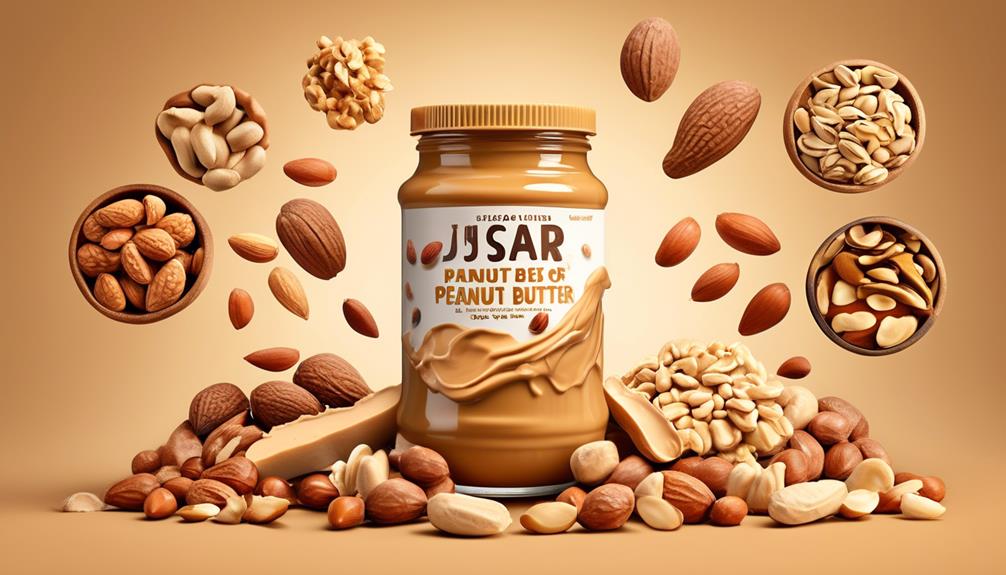
Rich in essential fatty acids, antioxidants, and monounsaturated fats, peanut butter is a valuable source of healthful nutrients that contribute to heart health and overall well-being. The fats in peanut butter include both omega-6 fatty acids and monounsaturated fats, which are beneficial for heart health. While it's high in fat, the majority is monounsaturated fat, which can help reduce the risk of heart disease when consumed as part of a balanced diet.
Additionally, the protein content in peanut butter is substantial, making it a satisfying and filling option. Protein not only aids in muscle repair and growth but can also help control blood sugar levels and appetite. By choosing natural or organic peanut butter without added sugars and trans fats, individuals can maximize the health benefits, including essential vitamins and minerals.
Incorporating peanut butter into meals and snacks can offer a delicious way to consume healthful fats and protein, contributing to overall well-being.
Vitamin and Mineral Content
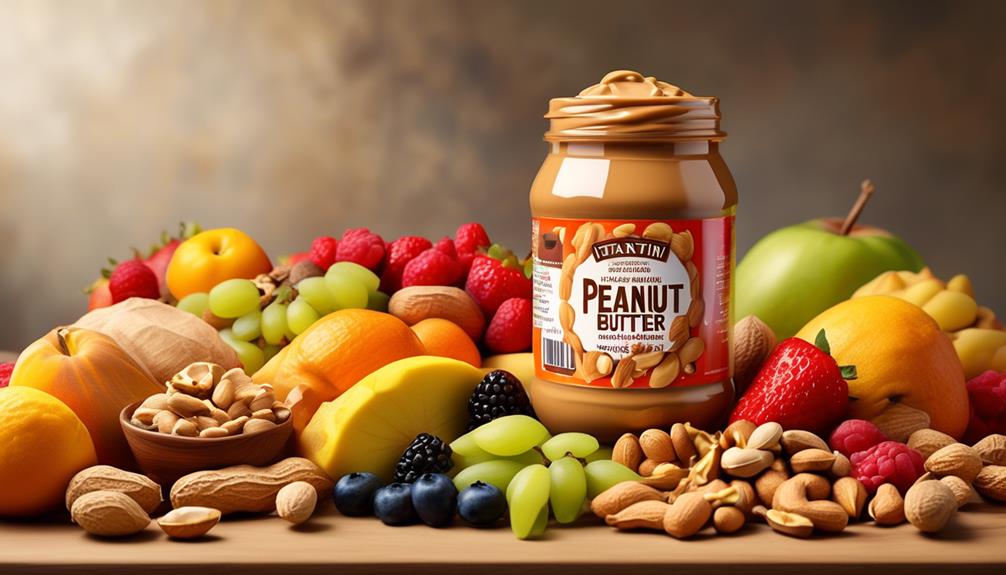
Peanut butter is a nutrient-rich spread that offers essential vitamins and minerals.
A 2-tablespoon serving provides approximately 2 mg of vitamin E, 49 mg of magnesium, and 208 mg of potassium.
Additionally, it contains niacin and small amounts of zinc, contributing to energy production, metabolism, immune function, and wound healing.
Nutrient-Rich Spread
Containing a wealth of essential vitamins and minerals such as vitamin E, magnesium, and potassium, peanut butter is a nutrient-rich spread that contributes to a balanced diet and supports overall wellness.
Peanut butter is a good source of protein, essential amino acids, and healthy fats, making it beneficial for muscle repair, immune system function, and weight loss.
The heart-healthy monounsaturated and omega-6 fatty acids in peanut butter may lower the risk of developing heart disease.
Moreover, the vitamin E content in peanut butter supports skin and hair health, while the magnesium and potassium help regulate blood sugar levels.
Incorporating natural or organic peanut butter into a balanced diet can provide these essential nutrients and promote overall health.
It's important to be mindful of portion sizes and choose natural varieties to maximize the nutrient benefits of peanut butter.
Essential Vitamins and Minerals
Packed with a plethora of vital nutrients, peanut butter serves as a substantial source of essential vitamins and minerals necessary for maintaining overall health and well-being. It contains protein, fiber, niacin, magnesium, phosphorous, zinc, and vitamin B-6, contributing to a healthful diet. These nutrients support nerve function, insulin sensitivity, and aid in maintaining a healthy weight.
The nutrient profile of peanut butter also includes monounsaturated and polyunsaturated fatty acids, which can reduce the risk of heart disease by lowering bad cholesterol levels. Additionally, the rich antioxidants and essential fatty acids in peanut butter contribute to cell repair, skin health, and protection against oxidative stress.
Despite these benefits, it's crucial to consume peanut butter in moderation due to its high calorie, saturated fat, and sodium content.
Dietary Fiber Contribution
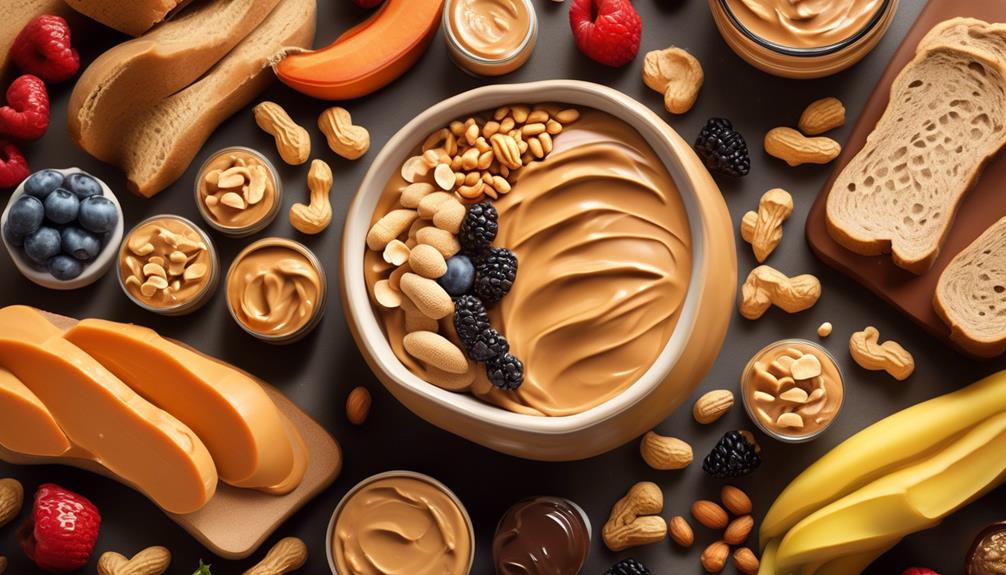
With approximately 2 grams of dietary fiber in a 2-tablespoon serving, peanut butter is a significant contributor to daily fiber intake, promoting digestive health and supporting overall well-being. Peanut butter's high fiber content aids in digestion, promotes a feeling of fullness, and supports the growth of healthy gut bacteria. It helps manage blood sugar levels and lower cholesterol, potentially lowering the risk of heart disease. Including peanut butter in the diet not only adds to the daily fiber intake but also contributes to overall digestive health and regularity. Choosing natural or organic peanut butter options can maximize the dietary fiber contribution while avoiding added sugars and unhealthy fats.
- Peanut butter's high fiber content aids in digestion and promotes a feeling of fullness.
- It supports the growth of healthy gut bacteria, contributing to overall digestive health.
- The dietary fiber in peanut butter can help manage blood sugar levels and lower cholesterol, potentially lowering the risk of heart disease.
- Choosing natural or organic peanut butter options maximizes the dietary fiber contribution while avoiding added sugars and unhealthy fats.
Antioxidant Properties
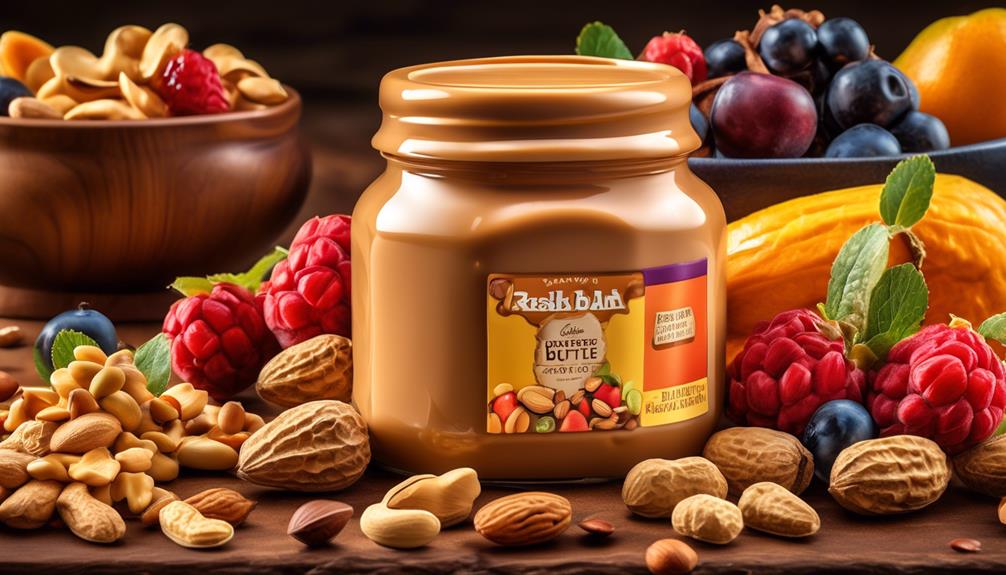
The antioxidant properties of peanut butter are worth exploring, as they play a significant role in promoting overall health.
The presence of antioxidants, such as vitamin E and resveratrol, in peanut butter may contribute to reducing the risk of chronic diseases.
These antioxidants help protect the body's cells from free radical damage, offering potential benefits in disease prevention and free radical defense.
Health Benefits
Containing antioxidants such as vitamin E and p-coumaric acid, peanut butter plays a significant role in combating oxidative stress and protecting cells from damage, thereby contributing to reducing the risk of chronic diseases such as heart disease and certain types of cancer.
Regular consumption of peanut butter is a good option for promoting overall health, as its antioxidant properties support the body's defense against free radicals and inflammation. This may help reduce your risk of heart disease and certain types of cancer.
Additionally, a high intake of peanut butter may contribute to a lower risk of chronic diseases. It's important to note that while peanut butter is healthy due to its antioxidant content, it's high in calories, so moderation is key.
Always consult a healthcare professional for diagnosis or treatment.
Disease Prevention
Taking into account its potent antioxidant properties, peanut butter plays a crucial role in preventing diseases and promoting overall health.
Studies have shown that peanut butter, with its high antioxidant content, can help prevent oxidative stress and reduce the risk of chronic diseases. The antioxidants in peanut butter contribute to maintaining good cholesterol levels, blood sugar levels, and blood pressure, making individuals less likely to develop heart disease.
Furthermore, the presence of antioxidants in peanut butter may lower the risk of cancer and promote cell repair. Incorporating peanut butter into a balanced diet can help protect against oxidative damage and reduce the risk of developing type 2 diabetes.
Free Radical Defense
Boasting potent antioxidant properties, peanut butter actively defends the body against free radicals, mitigating the risk of cellular damage and chronic diseases. The antioxidants in peanut butter, such as vitamin E and flavonoids, help neutralize free radicals, protecting cells and tissues from oxidative stress. Consuming peanut butter with antioxidant properties may contribute to lower risks of cancer, heart disease, and other chronic conditions by combating free radicals.
Additionally, these antioxidants promote cell repair and enhance the body's defense against oxidative damage, ultimately boosting overall health and well-being. Including peanut butter with antioxidant properties in our diet supports the body's natural defense system, contributing to long-term health.
With its high content of oleic acid and vitamin B, peanuts play a crucial role in safeguarding our health and well-being.
Satiety and Energy Boost
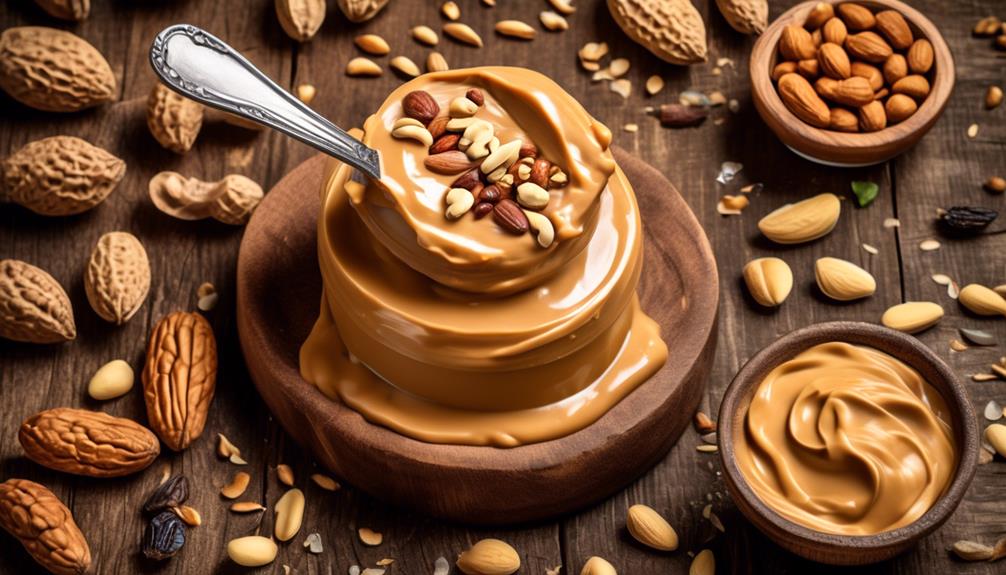
Peanut butter provides a sustained feeling of fullness and a reliable source of energy due to its high protein and healthy fat content. The protein in peanut butter helps to regulate appetite and increase satiety, which can aid in weight management. Additionally, the healthy fats in peanut butter provide a slow-burning source of energy, which can help maintain stable blood sugar levels and prevent energy crashes. This combination of protein and healthy fats makes peanut butter an excellent choice for a satisfying snack or addition to meals.
In terms of health, peanut butter is relatively high in calories, so portion control is important, especially for those watching their calorie intake. However, the fats in peanut butter are predominantly heart-healthy monounsaturated and polyunsaturated fats, which can have a positive impact on cholesterol levels and overall heart health. Peanuts, the main ingredient in peanut butter, also contain various nutrients and antioxidants that contribute to its health benefits.
It's important to note that while peanut butter has numerous health benefits, it's crucial to choose natural varieties without added sugars and excessive salt to minimize potential risks associated with processed foods.
Frequently Asked Questions
What Are the Benefits of Eating Peanut Butter?
Eating peanut butter offers numerous benefits.
It's a rich protein source, aiding muscle repair and growth.
The healthy fats support heart health, lowering the risk of heart disease.
Packed with vitamins and minerals, it contributes to overall well-being.
Its protein-fiber combo aids weight management and appetite control.
Moreover, it helps with blood sugar management, reducing the risk of type 2 diabetes.
Including it in a balanced diet promotes overall health and wellness.
Why Is Peanut Butter so Good?
Peanut butter is good due to its rich protein, healthy fats, and essential nutrients. It's beneficial for heart health, appetite control, and weight management.
Additionally, its versatility makes it a convenient, nutritious option for various recipes and snacks.
When opting for peanut butter, choosing natural or organic varieties without added sugars, oils, or trans fats maximizes its health benefits.
Is Peanut Butter OK to Eat Everyday?
Oh, peanut butter? Absolutely! We make it a daily staple. Packed with protein, healthy fats, and essential nutrients, it's a great addition to our diet.
Research suggests it can improve heart health, regulate blood sugar, and reduce the risk of certain diseases. Just be mindful of portion sizes and opt for natural, sugar-free options.
It's all about balance and moderation.
Why Is a Spoonful of Peanut Butter Good for You?
A spoonful of peanut butter is good for us because it provides a healthy dose of protein, fiber, and essential nutrients like magnesium, phosphorus, and vitamin B-6. This combination supports heart health, helps with appetite control, and can aid in weight management.
Additionally, peanut butter can help regulate blood sugar levels, making it a suitable option for individuals with type 2 diabetes. Its versatility also allows for easy incorporation into various dishes and snacks.
Conclusion
In conclusion, peanut butter offers a wealth of nutritional benefits. It is rich in protein, which is essential for muscle repair and growth. Peanut butter also contains heart-healthy monounsaturated fats. These fats can help improve cholesterol levels and lower the risk of heart disease.
Additionally, peanut butter is a good source of fiber, vitamins, and minerals. The fiber helps with digestion and can promote a feeling of fullness. The vitamins and minerals in peanut butter contribute to overall health and well-being.
Another benefit of peanut butter is its antioxidant properties. Antioxidants help protect the body against damage from harmful free radicals. This added protection can have a positive impact on long-term health.
It is important to note that while peanut butter is nutritious, it should be consumed in moderation. It is high in calories, so excessive consumption can lead to weight gain. However, incorporating peanut butter into a balanced diet can provide a satisfying and energy-boosting addition.
So, next time you enjoy that creamy peanut butter on your toast, remember the array of benefits it brings to your health.
From sneaky childhood butter licks to penning some of our most popular articles, Jamie’s journey with butter has been lifelong. His culinary background gives him a unique perspective, allowing him to craft mouthwatering articles that educate and tantalize equally. Jamie’s travel adventures revolve around finding the world’s best buttery treats when he isn’t writing.
-

 Recipes & Culinary Uses2 months ago
Recipes & Culinary Uses2 months agoHow Many Sticks of Butter Equals a Pound: A Handy Guide
-

 Shopping Guides1 month ago
Shopping Guides1 month agoWhere to Buy Raw Butter
-

 Recipes & Culinary Uses4 weeks ago
Recipes & Culinary Uses4 weeks agoMake Homemade Butter from Milk at Home
-

 Recipes & Culinary Uses4 weeks ago
Recipes & Culinary Uses4 weeks agoMake Creamy Butter From Buttermilk
-

 Butter Tips and Tricks3 months ago
Butter Tips and Tricks3 months agoHow Long Can You Use Butter After the Expiration Date?
-

 Recipes & Culinary Uses2 months ago
Recipes & Culinary Uses2 months agoMake Your Own Homemade Spray Butter
-

 Butter Tips and Tricks3 months ago
Butter Tips and Tricks3 months agoHow Much Butter to Use Instead of 1/3 Cup Oil
-

 Butter Tips and Tricks3 months ago
Butter Tips and Tricks3 months agoHow Many Calories Are in a Stick of Butter: A Comprehensive Guide




















